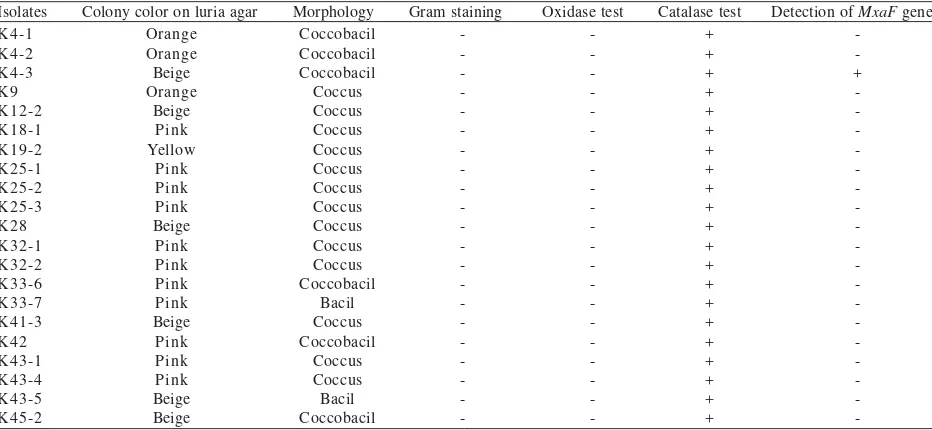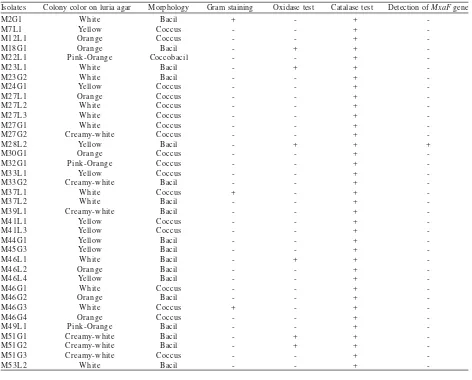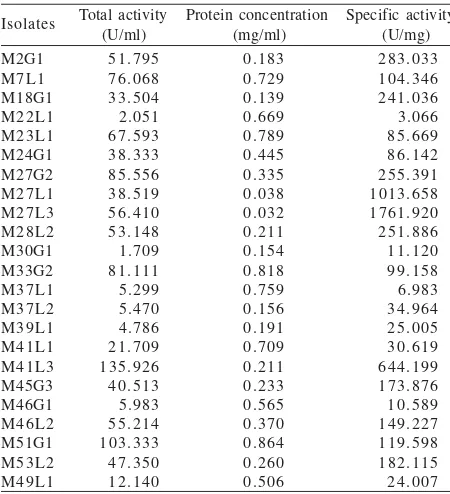Vol. 18 No. 1, p 11-15 EISSN: 2086-4094
http://journal.ipb.ac.id/index.php/hayati DOI: 10.4308/hjb.18.1.11
Isolation and Identification of Methylotrophic Bacteria Producing
Methanol Dehydrogenase from Human Feet and Mouth
DIANA ELIZABETH WATURANGI∗∗∗∗∗, CATHERINE DELANY NICHOLAS, CINDY OKTAVIA SUSANTO, MAGGY THENAWIJAYA SUHARTONO
Faculty of Biotechnology, Atma Jaya Catholic University of Indonesia, Jalan Jenderal Sudirman 51, Jakarta Selatan 12930, Indonesia
Received June 26, 2010/Accepted April 14, 2011
The human feet and mouth are known as sources of methylated sulfides, which are produced by other microflora. Methylated sulfides could be oxidized by methylotrophic bacteria, which may result in odor reduction in human feet and mouth. In this study, we collected a total of 21 isolates from human feet, and 37 isolates from human mouth. These isolates were identified with biochemical test such as oxidase and catalase test and Gram staining assay. The presence of mxaF gene of methanol dehydrogenase was detected by PCR using specific primers. However, the result showed that most of the isolates did not possess mxaF gene. Hence, the methanol dehydrogenase (MDH) activity was also determined. From the total 21 isolates obtained from the feet, only 15 of them showed MDH activity whereas 23 isolates from the total 37 isolates obtained from teeth and tongue region also showed MDH activity. Isolate K25-3 (74.444 U/ml), K33-6 (79.815 U/ml), and K43-5 (69.259 U/ml) from human feet and M41L3 (135.926 U/ml), M27G2 (85.556 U/ml), and M51G1 (103.333 U/ml) from human mouth showed the highest total enzyme activity. Isolates with the highest total activity could be used for further studies such as purification of the enzyme and isolates characterization.
Key words: methylotrophic bacteria; methanol dehydrogenase
___________________________________________________________________________
_________________
∗ ∗∗
∗∗Corresponding author. Phone: +62-21-5703306 ext. 330,
Fax: +62-21-5719060, E-mail: [email protected] INTRODUCTION
Methylotrophic bacteria are aerobic bacteria that utilize one-carbon compounds, such as methane, methanol, and methylated compounds containing sulfur, as sources of carbon and energy (Hanson & Hanson 1996). Methylotrophic bacteria are found in a variety of habitats such as leaf, polluted water, air, soil (Pasamba et al. 2007), drinking water (Gallego et al. 2005), vehicular soot (Jang & Lee 2008), and rice (Madhaiyan et al. 2007). Interestingly, methylotrophic bacteria are also found as a normal part of microflora in human mouth and feet (Anesti et al. 2004; Anesti et al. 2005).
The human mouth and feet are sources of volatile one carbon compounds such as methanethiol and dimethylsulphide. These compounds are produced by diverse bacteria colonizing the human mouth and foot habitat (Goldberg et al. 1997; Anesti et al. 2004; Anesti et al. 2005). Thus, methylotrophic bacteria occur in that habitat and utilize volatile one carbon compounds as their energy source. The enzymes of methylotrophic metabolism play an important role in methylotrophic bacteria’s ability to use one carbon compounds as energy source. One of these methylotrophic enzymes is methanol dehydrogenase (MDH).
MDH carries out a key step in methylothropic bacteria since it catalyzes oxidation of methanol to formaldehyde; after which the formaldehyde can further metabolize to formate through some reaction (Chistorserdova et al.
2004). MDH exists in an α2β2 tetramer. The larger? α -subunit is 66 kDa and the? β-subunit is only 8.5 kDa. In the active site, there are pyroloquinoline quinon (PQQ) and a Ca2+ ion which are bound non-covalently to each of
α subunit. They are both key to the action of methanol dehydrogenase (Liu et al. 2006).
Genetics of methanol oxidation in Methylobacterium
extorquens AM1 have been studied. There are at least 17
genes that play a role in this process. Three of these genes encode the structural protein of a methanol oxidation complex. The mxaF and mxaI encode the large á and small
β subunit of MDH. The mxaG encodes the primary electron acceptor for MDH (McDonald & Murel 1997).
Although there are some studies about the methylotrophic bacteria, there are still quite a few. Moreover, these studies were done in subtropical areas. Regarding this issue, it is important to investigate the methylotrophic bacteria occurring in tropical area. We now report the isolation and identification of methylotrophic bacteria in human mouth and feet from a tropical region. The activity of methanol dehydrogenase was also determined.
MATERIALS AND METHODS
swabbing with sterile cotton bud. The sample obtained on cotton buds was streaked directly onto minimal media (bacteriological agar) supplemented with 1% (v/v) methanol (Riupassa & Suwanto 2004). After that, the media were incubated at 28 oC for approximately 1 week.
Methylotrophicbacteria were then isolated and stored in minimal media supplemented with 1% (v/v) methanol and Luria agar media supplemented with 0.01% (w/v) cycloheximide (Sigma-Aldrich,USA) to reduce fungi contamination (Riupassa & Suwanto 2004).
Methylotrophic Bacteria Identification. Biochemical assays used to identify the isolates were catalase test and oxidase test. Gram staining was also performed to differentiate the isolates.
Extraction of Genomic DNA. Cultures were enriched in Luria Agar medium at 28 oC for 2 days and genomic
DNA was extracted using Cetyltrimethylammonium bromide (CTAB) method (Marchesi et al. 1998).
Detection of mxaF Gene by PCR. Amplification of
mxaF gene was achieved by amplification with specific primer for mxaF gene. Primer used in this study are primer f1003 GCGGCACCAACTGGGCTGGT) and r1561 (5’-GGGCAGCATGAAGGGCTCCC), according to Mcdonald and Murrel (1997) and Anesti et al. (2005). PCR amplification was performed in 25 µl reaction mixture with Gene PCR System 2700 (Applied biosystems). Reactant used for amplification was GoTaq® Green Master Mix. The PCR conditions were 30 cycles of 92 oC for 1 minute,
55 oC for 1 minute, and 72 oC for 1 minute. The presence of
single band of expected size (550 bp) was confirmed by 0.8% agarose gel electrophoresis.
Cultivation of Bacteria for Enzyme Assay. Bacteria cultivation method was based on a research by Liu et al.
(2006). The media was modified with Luria broth [1% (w/ v) tryptone, 0.5% (w/v) yeast extract, and 1% (w/v) NaCl] and cultivated at 28 oC, 110 rpm for 66 hours.
Enzyme Extraction. Bacteria isolates were harvested by centrifugation (Sorvall LegendTM RT) at 9.000
× g for
45 minutes. The pellet was suspended in distilled water (w/v= 1:4). Intracellular enzyme and methanol
dehydrogenase from periplasm space were obtained by breaking down the membrane of bacteria. The suspension was treated for 2 minutes with an ultrasonic device (Biologics Inc., ultrasonic homogenizer, model 150 V/T), output 50, using 65% pulses. The lysate was then centrifuged at 9.000 × g (Sorvall LegendTM RT) for 60
minutes to separate the cell from other solute. The resulting supernatant was mixed with 100 mM 4-morpholine ethanesulfonic acid (Mes) (Sigma-Aldrich, USA) (v/v= 3:1) to a final buffer concentration of 25 mM (Liu et al.
2006). Crude extract was stored in freezer (- 20 oC) for further
analysis.
Enzyme Assay. The assay mixture contained 100 mM Tris-HCl buffer pH 8, 15 mM NH4Cl, 10 mM CH3OH as substrate, 50 µM 6-dichloroindophenolate (DCIP) (Sigma-Aldrich, Austria), 0.33 mM Phenazine methosulfaten (PMes) (Sigma-aldrich, Germany) and the crude extract (75-150 µl). The reaction was initiated by the addition of PMes and methanol dehydrogenase activity was measured by the decrease of DCIP absorbance at 600 nm within 1 minute (Liu et al. 2006) at pH 8.0 and room temperature (25
oC). The assay mixture without enzyme served as the
control. One unit of enzyme activity was defined as the amount that catalyzed the reduction of 1 µmol DCIP per minute. Protein concentrations were determined by the Bradford method with Bovine Serum albumin (BSA) as the standard (Bradford 1976).
RESULTS
Methylotrophic Bacteria Isolation from Human Feet and Mouth. From 55 human subjects (age 20-22 years) lived in Jakarta, Indonesia, a total of 58 isolates collected. 21 of them were obtained from human feet, and 37 of them from human mouth.
Methylotrophic Bacteria Identification. The colors of the isolates vary between pink, beige, orange, and yellow. Various morphology and different results of oxidase and catalase test were also shown among the isolates (Table 1 & 2).
Table 1. The biochemical properties and characteristics of the isolates obtained from human feet
Extraction of Genomic DNA and Detection of mxaF Gene by PCR. The genomic DNA of the isolates was extracted using CTAB method (Marchesi et al. 1998). Genomic DNA of the isolates was used as template in detection of mxaF gene. The expected amplicon size is approximately 550 bp. Most of the isolates show negative result of detection mxaF gene. Only one isolate from human feet (isolate K4-3) and one isolate from human mouth (isolate M28L2) were produced DNA fragment of the expected size (Figure 1).
Enzyme Extraction and Enzyme Assay. From the total 21 isolates obtained from the feet, 15 isolates showed MDH activity whereas 23 isolates from the total 37 isolates obtained from human mouth also showed MDH activity (Table 3 & 4). The highest total activity of methanol dehydrogenase comes from isolate K25-3 (74.444 U/ml), K33-6 (79.815 U/ml), and K43-5 (69.259 U/ml) from human feet and M41L3 (135.926 U/ml), M27G2 (85.556 U/ml), and M51G1 (103.333 U/ml) from human mouth.
DISCUSSION
Methanol dehydrogenase is an enzyme produced by methanol consuming bacteria such as methylotrophic
Table 2. The biochemical properties and characteristics of the isolates obtained from human mouth
Isolates Colony color on luria agar Morphology Gram staining Oxidase test Catalase test Detection of MxaF gene
bacteria. This group of bacteria is known as one of microfloras in human feet and mouth. In this study, samples from human feet and mouth were collected and analyzed further.
The isolates had varied in pigmentation, Gram staining result, biochemical properties, and morphology (Table 1 & 2).
These results suggested the diversity of methylotrophic bacteria occurring in human feet and mouth. All isolates were catalase-positive, indicating that they have catalase enzyme which could degrade hydrogen peroxide to oxygen. Thus, it is suggested that all of the isolates were aerobic bacteria. This observation was similar to previous study which reported that biochemichal properties of methylotrophic bacteria isolated from human feet and mouth were catalase-positive (Anesti et al. 2004, 2005). It is suggested that catalase-positive is a
Table 4. The result of the activity assay of methanol dehydrogenase from human mouth
Total activity Protein concentration Specific activity
characteristic of methylotrophic bacteria. Most of the isolates were Gram negative bacteria and oxidase-negative. This result showed that most of the isolates did not possess cytochrome oxidase which catalysed the transport of electrons from donor compounds to electron acceptors.
In order to detect the presence of mxaF gene, genomic DNA of the isolate was extracted and amplified by PCR using primers f1003 and r1561. These primers have previously been used to amplify mxaF gene from a variety of different environments (McDonald & Murrel 1997). Surprisingly, in this study PCR amplification results showed that most of the isolates did not possess the mxaF
gene. Only one isolate from human feet (isolate K43) and one isolate from human mouth (isolate M28L2) produced the DNA fragments with the correct size (550 bp). In contrast, amplification of mxaF gene by Anesti et al. (2004 & 2005) showed that most of methylotrophic bacteria obtained from human feet and human mouth possess the
mxaF gene.It may be possible that most of the isolates obtained in this study have different mxaF sequence. However, a total of 38 from 58 isolates showed the presence of methanol dehydrogenase activities (Table 3 & 4). These results supported the suggestion that the isolates obtained in this study may have different mxaF sequence.
The isolates were then further analyzed to determine MDH activity. After the crude extract of the enzymes were collected, the enzyme activity was determined based on spectrophotometry analysis (Table 3 & 4). From the total of 58 isolates obtained from both habitates, 38 isolates showed MDH activity. However, all isolates showed growth on minimal medium supplemented with 1% (v/v) methanol.
Methanol dehydrogenase activity was undetectable in other isolates presumably due to the the low production of the enzyme, the possible presence of interfering or inhibitory compounds in the crude extract and the reduced accuracy of the enzyme assay at low enzyme purity (Liu
et al. 2006). Additionally, there might be certain factors
that influenced the activity or the catalytic reaction of the enzyme, such as pH, temperature, and cofactors.
The specific activity might become higher than the enzyme activity since the specific activity is also depends on the protein concentration (Table 3 & 4). The specific activity presumably shows the purity of the enzyme. But due to the low purity, we cannot assume that the isolate with highest specific activity possesses the most potential enzyme. Therefore, the isolates with the highest total activity been picked instead of isolates with highest specific activity. These isolates were K25-3 (74.444 U/ml), K33-6 (79.815 U/ml), and K43-5 (69.259 U/ml) from human feet and M41L3 (135.926 U/ml), M27G2 (85.556 U/ml), and M51G1 (103.333 U/ml) from human mouth. However, the instability of methanol dehydrogenase activity might be found since the crude extract was used in enzyme assays. The methanol dehydrogenase from the isolate used by Liu et al. (2006) showed the stability of total activity after some steps of enzyme purification. Therefore, the purification of the methanol dehydrogenase could also
Table 3. The result of the activity assay of methanol dehydrogenase from human feet
be considered due to the instability of the enzyme in the crude extract.
Further study on factors which affect the activity of the enzyme such as pH, temperature, cofactors is needed to get more information on characteristic of methanol dehydrogenase and increase the activation of methanol dehydrogenase.
ACKNOWLEDGEMENT
This work was supported by Hibah Bersaing, Direktorat Jenderal Pendidikan Tinggi (DIKTI) 2009, Indonesia.
REFERENCES
Anesti V, Mcdonald IR, Ramaswamy M, Wade WG, Kelly DP, Wood AP. 2005. Isolation and molecular detection of methylotrophic bacteria occurring in the human mouth.
Environ Microbiol 7:1227-1238.
doi:10.1111/j.1462-2920.2005.00805.x
Anesti V, Vohra J, Goonetilleka S, Mcdonald IR, Sträubler B, Stackebrandt E, Kelly DP, Wood AP. 2004. Molecular detection and isolation of facultatively methylotrophic bacteria, including Methylobacterium podarium sp. Nov., from the human foot microflora. Environ Microbiol 6:820-830.
doi:10.1111/j.1462-2920.2004.00623.x
Bradford MM. 1976. A rapid and sensitive methods for the quantification of microgram quantities of protein utilizing the principle of protein-dye binding. Anal Biochem 71:248-254. doi:10.1016/0003-2697(76)90527-3
Chistoserdova L, Laukel M, Portais JC, Vorholt JA, Lindstrom ME. 2004. Multiple formate dehydrogenase enzymes in the facultative methylotroph Methylobacterium extorquens AM1
are dispensable for growth on methanol. J Bacteriol 186:22-28. doi:10.1128/JB.186.1.22-28.2004
Gallego V, Garcia MT, Ventosa A. 2005. Methylobacterium
variabile sp. nov., a methylotrophic bacterium isolated from
an aquatic environment. Int J Syst Evol Microbiol 55:1429-1433. doi:10.1099/ijs.0.63597-0
Goldberg S, Cardash H, Browning H, Sahly H, Rosenberg M. 1997. Isolation of Enterobacteriaceae from the mouth and potential association with malodor. J Dent Res 76:1770-1775.
doi:10.1177/00220345970760110801
Hanson RS, Hanson TE. 1996. Methanotrophic bacteria. Microbiol Rev 60:439-471.
Jang SB, Lee AC. 2008. Phenotypic characterization of pink pigmented facultative methylotrophic bacteria from soil exposed to vehicular soot. Phillipp J Syst Biol 2:32-39. Liu Q, Kirchhoff JR, Faehnle CR, Viola RE, Hudson RA. 2006. A
rapid method for the purification of methanol dehydrogenase from Methylobacterium extorquens. Prot Express Pur 46:316-320. doi:10.1016/j.pep.2005.07.014
Madhaiyan M, Kim BY, Poonguzhali S, Kwon SW, Song MH, Ryu JH, Go SJ, Koo BS, Sa TM. 2007. Methylobacterium oryzae
sp. nov., an aerobic, pink-pigmented, facultatively methylotrophic, 1-aminocyclopropane-1-carboxylate deaminase-producing bacterium isolated from rice. Int J Syst Evol Microbiol 57:326-331. doi:10.1099/ijs.0.64603-0
Marchesi JR, Sato T, Weightman AJ, Martin TA, Fry JC, Hiom SJ, Wade WG. 1998. Design and evaluation of useful bacterium-specific PCR primers that amplify genes coding for bacterial 16S rRNA. Appl Environ Microbiol 64:795-799.
McDonald IR, Murrel JC. 1997. The methanol dehydrogenase structural gene mxaF and its use as a functional gene probe for methanotrophs and methylotrophs. Appl Environ
Microbiol 63:3218-3224.
Pasamba EM, Demigillo RM, Lee AC. 2007. Antibiograms of pink pigmented facultative methylotrophic bacterial isolates from various sources. Philipp Scient 44:47-56.


